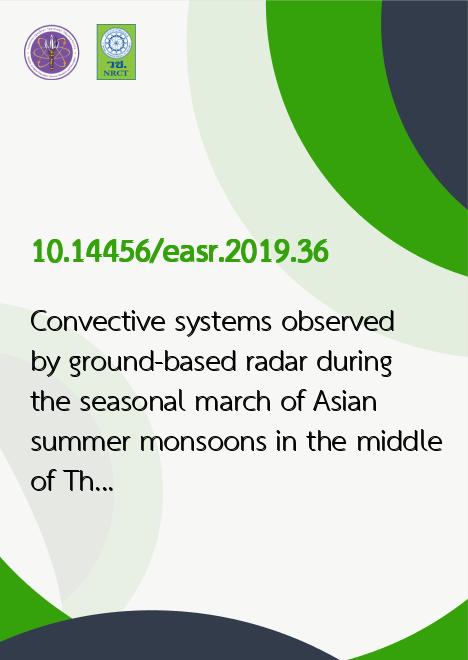
|
Convective systems observed by ground-based radar during the seasonal march of Asian summer monsoons in the middle of Thailand |
|---|---|
| รหัสดีโอไอ | |
| Creator | 1. Nattapon Mahavik 2. Sarintip Tantanee |
| Title | Convective systems observed by ground-based radar during the seasonal march of Asian summer monsoons in the middle of Thailand |
| Publisher | Faculty of Engineering, Khon Kaen University |
| Publication Year | 2562 |
| Journal Title | Engineering and Applied Science Research |
| Journal Vol. | 46 |
| Journal No. | 4 |
| Page no. | 318-330 |
| Keyword | Convective systems, Ground-based radar, Hot spot analysis, Classify moving rain systems, Thailand |
| URL Website | https://www.tci-thaijo.org/index.php/easr/index |
| Website title | Engineering and Applied Science Research |
| ISSN | 2539-6161 |
| Abstract | Understanding the characteristics of clouds is essential to support disaster mitigation and improvement of cultivation planning. Convective systems (CS) are a major contributor to the total number of rain systems over the tropics. In this study, the spatio-temporal characteristics of CSs extracted from instantaneous ground-based radar observations in Phetchabun, in central Thailand, were investigated during the seasonal march of Asian summer monsoons from July to September of 2010. The Open Source Library for Weather Radar Data Processing (Wradlib) was used to create gridded radar reflectivity at instantaneously observed times at a constant altitude of 3 km above the mean sea surface level. The geometric properties of the largest CS, such as echo size, fitted ellipse, and centroid, were also extracted and analyzed by applying the OpenCV library in a Python environment. CS classification produces two classes of CSs based on their speed, stationary and propagating. Propagating CSs are most frequent in August, accounting for 20% of the total number. Additionally, the propagating CSs in August cover relatively larger areas and produce stronger radar echoes than others, while stationary CSs in August have relatively more elongated forms. Classifying CSs based on direction, previous instantaneous scans show that the westerly class dominates across the study area, especially in August. Moreover, the westerly class is associated with stronger radar echoes compared to the easterly class. Additionally, the average speed of the easterly class has a tendency to decrease toward the end of the rainy season. The hot spot area with regard to CS severity has been identified as being in the southwest part of the study area. |